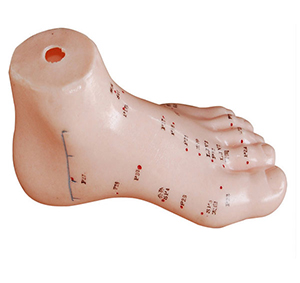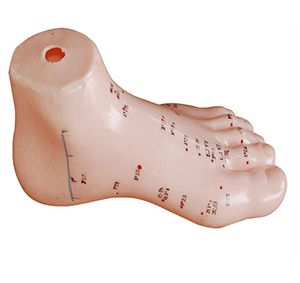As an important branch of acupuncture treatment, foot acupuncture has been widely used in the treatment of various chronic diseases, pain management and medical conditioning. However, the complexity of foot anatomy and individual differences make the traditional foot acupuncture operation difficult, especially in the precise location of acupoints, acupuncture depth and Angle control, which often bring challenges to clinicians. So, can the foot acupuncture model break through these practical bottlenecks, thereby improving the accuracy and efficacy of treatment?
1. Complexity of foot anatomy and difficulty of acupuncture

The foot contains a large number of nerves, blood vessels, muscles and skeletal structures, and foot acupuncture treatment requires precise positioning of specific acupoints. Traditional foot acupuncture treatment often relies on clinical experience, and the Angle and depth of acupuncture are difficult to quantify and control, which can easily lead to improper acupuncture or operation deviation, especially for novice or less experienced acupuncturists.
Studies have shown that the anatomical variation of the foot is large, and the structural differences of the foot in different patients will affect the acupuncture effect. Acupuncture in Medicine According to a study in 2019, anatomical variation of the foot may lead to misacupuncture of certain acupuncture points, thus affecting the therapeutic effect. In the absence of a standardized model, it is difficult to effectively avoid this situation, especially when personalized treatment is carried out.
2. Clinical significance of foot acupuncture model
The introduction of foot acupuncture model provides the possibility to solve the above problems. By highly reducing the anatomical structure of the foot, the standardized foot acupuncture model can accurately show the anatomical position of each acupoint on the foot, the direction of meridians, and the distribution of related nerves and blood vessels. Such models can be used as teaching tools, clinical operation simulators, and personalized treatment AIDS to help acupuncturists improve the accuracy of treatment.
A 2017 study published in the Journal of Acupuncture and Tuina Science pointed out that acupuncturists who used the foot acupuncture model for preclinical training improved the accuracy of acupoint location and acupuncture depth by more than 20%. In addition, the model helps clinicians better understand and circumnavigate differences in foot anatomy types, enabling more personalized and precise treatment.
3. Data support and practical application
Through accurate simulation, the foot acupuncture model not only improves the accuracy of acupuncture technique, but also provides strong support for clinical efficacy. A typical example is that with the help of the foot acupuncture model, clinicians are able to more accurately assess the foot characteristics of each patient and tailor acupuncture protocols based on these characteristics to further improve treatment outcomes.
Research published in the Chinese Journal of Integrative Medicine in 2021 shows that patients who use the foot acupuncture model to guide clinical treatment can improve their overall treatment effectiveness by about 15% to 25%, especially when treating painful diseases such as plantar fasciitis and knee pain. The patient's recovery rate was significantly accelerated. This study further confirmed the clinical value of foot acupuncture model in breaking through the bottleneck of traditional foot acupuncture treatment.
4. Summary and outlook
To sum up, the emergence of foot acupuncture model undoubtedly breaks through the bottleneck of actual operation in foot acupuncture treatment to a certain extent. It not only helps acupuncturists to improve the location of acupoints and acupuncture accuracy, but also provides more personalized treatment plans, thereby enhancing the overall treatment effect. With the continuous progress of technology, the future foot acupuncture model may integrate more intelligent functions, such as virtual reality (VR) and augmented reality (AR) technology, which will further broaden its application field and improve the accuracy and effect of clinical treatment.
In the future of foot acupuncture therapy, foot acupuncture model will undoubtedly become an important tool to improve the quality of treatment, accelerate the learning of doctors and improve the efficiency of treatment.

